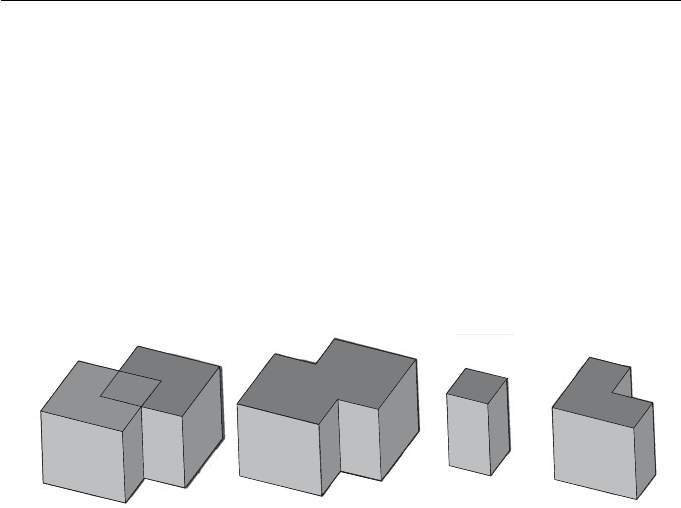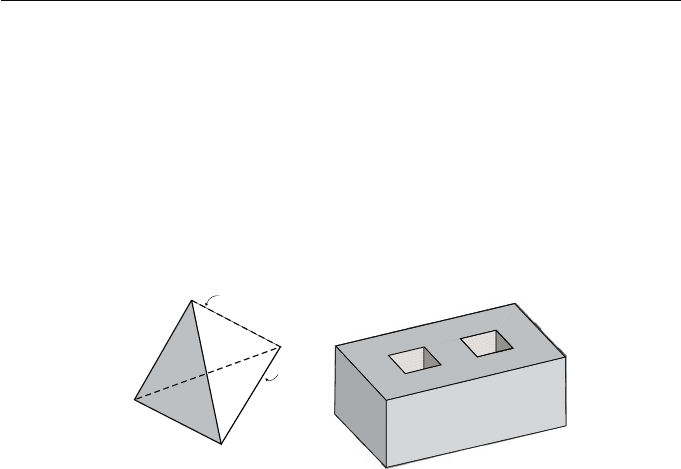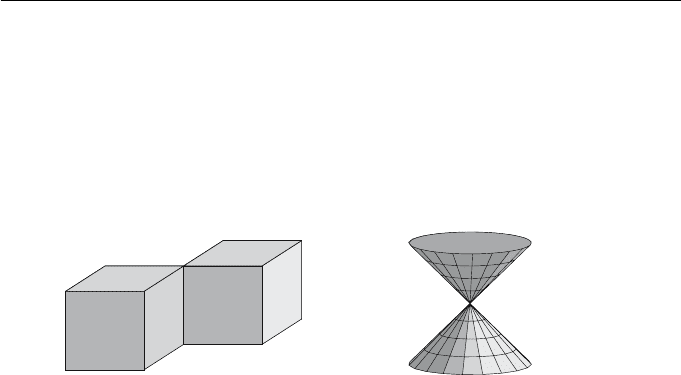Marsh D. Applied Geometry for Computer Graphics and CAD
Подождите немного. Документ загружается.


258 Applied Geometry for Computer Graphics and CAD
The derivation of the Gordon–Coons surface can be generalised to give a
loft surface that interpolates four boundary curves c(t), d(t), e(s)andf (s)and
satisfies four derivative conditions c
s
(t), d
s
(t), e
t
(s)andf
t
(s). The surface is
given by
x(s, t)=H(s)
⎛
⎜
⎜
⎜
⎜
⎝
−x
0,0
−x
0,1
−e
t
(0) −f
t
(0) c(t)
−x
1,0
−x
1,1
−e
t
(1) −f
t
(1) d(t)
−c
s
(0) −c
s
(1) −x
st,0,0
−x
st,0,1
c
s
(t)
−d
s
(0) −d
s
(1) −x
st,1,0
−x
st,1,1
d
s
(t)
e(s) f(s) e
t
(s) f
t
(s) 0
⎞
⎟
⎟
⎟
⎟
⎠
H(t)
T
, (9.23)
where
H =
H
0
H
1
ˆ
H
0
ˆ
H
1
1
,
and
x
0,0
= c(0) = e(0) , x
0,1
= c(1) = f(0) ,
x
1,0
= d(0) = e(1) , x
1,1
= d(1) = f(1) .
Note that the left hand H of Equation (9.23) is a function of s and the right
hand H
T
is a function of t. All the entries in the matrix can be obtained from
the specified curve and derivative data except for those involving x
st
. The four
values x
st,0,0
, x
st,0,1
, x
st,1,0
and x
st,1,1
are called twist vectors, and specify the
second order partial derivatives
∂
2
x
∂s∂t
(s, t) at the corners of the surface. They
can be used to control the shape of the interior of the surface without changing
the shape of the boundary curves.
The loft surface (9.23) can be used to obtain a G
1
network surface defined
by a grid of curves in a similar manner to the skin surface. In the case of a
network surface, the second order derivative terms x
st,i,j
must satisfy additional
compatibility conditions in order to achieve continuity at the corners:
x
st,0,0
=
de
t
ds
(0) =
dc
s
dt
(0) , x
st,0,1
=
df
t
ds
(0) =
dc
s
dt
(1) ,
x
st,1,0
=
de
t
ds
(1) =
dd
s
dt
(0) , x
st,1,1
=
df
t
ds
(1) =
dd
s
dt
(1) .
Example 9.27
Consider a Gordon–Coons surface given by linear boundary curves in the z =0
plane: c(t)=(0,t,0), d(t)=(1,t,0), e(s)=(s, 0, 0), and f (s)=(s, 1, 0). Let
the derivative conditions be c
s
(t)=(1, 0, 0), d
s
(t)=(1, 0, 0), e
t
(s)=(0, 1, 0),

9. Surfaces 259
and f
t
(s)=(0, 1, 0). Then
x(s, t)=H(s)
⎛
⎜
⎜
⎜
⎜
⎝
−(0, 0, 0) −(0, 1, 0) −(1, 0, 0) −(1, 0, 0) (0,t,0)
−(1, 0, 0) −(1, 1, 0) −(1, 0, 0) −(1, 0, 0) (1,t,0)
−(1, 0, 0) −(0, 1, 0) −x
st,0,0
−x
st,0,1
(0, 1, 0)
−(1, 0, 0) −(0, 1, 0) −x
st,1,0
−x
st,1,1
(0, 1, 0)
(s, 0, 0) (s, 1, 0) (1, 0, 0) (1, 0, 0) (0, 0, 0)
⎞
⎟
⎟
⎟
⎟
⎠
H(t)
T
.
If the twist vectors have zero z-component, then the Gordon–Coons surface has
zero z-component and so the surface is planar. However, if the twist vectors are
chosen so that they point out of the z = 0 plane, then the surface is no longer
planar despite the fact that the boundary curves and the derivatives lie in the
plane. The twist vectors provide a potentially powerful tool for surface design.
EXERCISES
9.19. Determine a skin surface that interpolates the curves c(t)=(3t
2
+
4, 2t
2
, −t)andd(t)=(2t, −t
4
, 2t +4),for0≤ t ≤ 1.
9.20. Let c(t)=(3t
2
, 2t
2
,t)andd(t)=(2t +10, 3t, 2t
2
). Determine the
loft surfaces that interpolate c(t)andd(t), and satisfy the derivative
conditions
a) c
s
(t)=(1, 1, 0) and d
s
(t)=(0, −1, 0),
b) c
s
(t)=(0, −t
2
, 0) and d
s
(t)=(−1,t
2
, −1).
9.21. Determine the Coons surface interpolating the four boundary B´ezier
curves
c(t)=(−5, −5, 0)B
0,1
(t)+(20, 3, 0)B
1,1
(t),
d(t)=(−8, 0, 10)B
0,2
(t)+(10, 16, 4)B
1,2
(t)+(27, 7, 10)B
2,2
(t),
e(s)=(−5, −5, 0)B
0,3
(s)+(−6, −4, 3)B
1,3
(s)
+(−7, −2, 7)B
2,3
(s)+(−8, 0, 10)B
3,3
(s),
f(s)=(20, 3, 0)B
0,2
(s)+(22, 5, 4)B
1,2
(s)+(27, 7, 10)B
2,2
(s).
9.22. Show that if two surfaces meet at a point P and the surfaces have
a common normal direction at P, then the surfaces meet with G
1
-
continuity.
9.23. Consider the skinning operation through two section curves with
general blending functions functions f
0
(s)andf
1
(s) that satisfy

260 Applied Geometry for Computer Graphics and CAD
f
0
(0) = f
1
(1) = 1, f
0
(1) = f
1
(0) = 0 and f
0
(s)+f
1
(s) = 1. Show
that the skin surface
x(s, t)=f
0
(s)c(t)+f
1
(s)d(t)
is planar whenever the boundary curves are coplanar.
9.24. Verify that the partial derivatives of the loft surface x(s, t)givenby
(9.18), and evaluated at s =0ands = 1, agree with the specified
derivative conditions c
s
(t)andd
s
(t) respectively.
9.25. Suppose two B´ezier surfaces B(s, t)=
n
i=0
p
j=0
b
i,j
B
i,n
(s)B
j,p
(t)
and C(s, t)=
n
i=0
p
j=0
c
i,j
B
i,n
(s)B
j,p
(t) (for (s, t) ∈ [0, 1]×[0, 1])
meet along a common boundary B(1,t)=C(0,t). Determine condi-
tions on the control points for the surfaces to have the same tangent
planes along the boundary.
9.7 Geometric Modelling and CAD
Geometric modelling is concerned with developing tools to create, represent,
and manipulate geometric shapes. Every commercial CAD system incorporates
a geometric modeller, an implementation of modelling tools that enable the user
to specify curves, surfaces and solids. Most systems are able to represent the
curve and surface types that were introduced in the earlier chapters such as
lines, conics, planes, quadrics, and B´ezier and B-spline curves and surfaces.
Geometric modellers make a careful distinction between surfaces and solids.
The term “sphere”, for instance, can refer to either the outer boundary surface
or to the solid consisting of the boundary and all the points inside. A solid
is a finite volume bounded by a finite number of surfaces. The intersections
of the bounding surfaces give the edges of the solid, and the intersections of
the edges give the vertices. For example, a solid cube is bounded by six planes.
The planes intersect to give twelve linear edges, and the edges intersect in eight
vertices. Each face of a cube is a planar region bounded by four of the edges.
In addition to the mathematical definitions of the surfaces and edges, a
specification of a solid requires information about the topology of the model,
that is, how the surfaces, edges and vertices interconnect. Not all modellers
can represent solids, and so those that do are referred to as solid modellers.A
number of different representations are used in both industrial and academic
modellers and some of these are described in the following sections.

9. Surfaces 261
9.7.1 Wireframe Modeller
A wireframe modeller uses curves to represent both surfaces and solids. Typi-
cally, the curves comprise the boundaries of each surface, and additional (pa-
rameter) curves to indicate the shape of each surface. The surfaces and solids
are not fully represented and no topological information is stored. Wireframe
modellers are very easy to implement and are useful for obtaining fast render-
ings of surfaces.
9.7.2 Surface Modeller
A surface modeller represents each surface mathematically, but no topological
information is stored and, therefore, there is no true concept of a solid. The
simplest type of surface modeller is the polyhedral modeller for which the sur-
faces are all planar. More sophisticated surface modellers are able to represent
B´ezier, B-spline and NURBS surfaces, and general parametric surfaces. Surface
modellers are useful for product concept, specification and styling, and may be
sufficient for some applications such as numerical controlled (NC) machining
and computer-aided manufacture (CAM).
9.7.3 Constructive Solid Geometry (CSG) Modellers
A constructive solid geometry (CSG) modeller uses implicit surface definitions
(see Section 9.1). An implicitly defined surface f(x, y, z) = 0 partitions the
three-dimensional workspace into two regions or half-spaces consisting of points
satisfying f(x, y, z) ≥ 0andf(x, y, z) ≤ 0 respectively. (Half-spaces can also
be constructed using > and <.) For instance, the unit sphere with the implicit
equation x
2
+ y
2
+ z
2
− 1 = 0 yields two half-spaces: the inside of the sphere,
which is the set of points (x, y, z) satisfying x
2
+y
2
+z
2
−1 ≤ 0, and the outside
which is the set of points satisfying x
2
+ y
2
+ z
2
− 1 > 0. Likewise, an infinite
plane divides the workspace into the two regions on either side of the plane.
Solids are defined in terms of half-spaces. For example, a hemisphere comprises
the points satisfying both x
2
+ y
2
+ z
2
− 1 ≤ 0andz ≥ 0, that is, the set of
points inside the sphere and to one side of the plane z =0.
The constructive solid geometry (CSG) modeller pre-defines a number of
solids called primitives. Common primitives include solids derived from planar
and quadric geometries such as spheres, cubes, cylinders and cones. A solid
can be represented by the modeller if it is one of the primitives or can be
constructed from the primitives by applying one or more modelling operations,

262 Applied Geometry for Computer Graphics and CAD
such as linear transformations (see Chapters 1 and 2), and Boolean operations.
Three Boolean operations are used: union, intersection and difference. Let
A and B be two sets of points representing solids or half-spaces. Then the
union of A and B, denoted A ∪ B, is the set of all points contained in A or B
(including those points in both A and B). The intersection of A and B, denoted
A ∩ B, is the set of all points contained in both A and B.Thedifference of A
and B, denoted A \B, is the set of all points contained in A but not contained
in B. Figure 9.18 exemplifies the three operations for two solid blocks. Boolean
operations are a more general concept than presented here and can be defined
for sets of any objects.
A
B
(a) (b) (c) (d)
Figure 9.18 (a) Blocks A and B, (b) union A ∪B, (c) intersection A ∩B,
and (d) difference A \ B
Example 9.28 (Boolean Operations)
In order to cut a hole in a block of material A (called the blank) it is necessary
to construct an object (called the tool ) that has the shape of the required hole.
Let B be a cylindrical tool. A transformation is applied to B so that it overlaps
the region of A where the hole is to be cut. Note that the tool can be larger
than the required hole. The material that is to be removed from the block is
obtained by performing the difference operation A \B as shown in Figure 9.19.
Whenever modelling operations are applied to objects there is a potential
problem that the result is invalid, that is, it cannot be represented by the mod-
eller. For instance, a modeller that can only represent curves and surfaces in
B´ezier form cannot represent the intersection of two B´ezier surfaces since the
curve of intersection is not (in general) a B´ezier curve. One of the strengths of
the CSG representation is that Boolean operations are guaranteed to give valid
results. Further, the implicit surface definitions make it straightforward to per-

9. Surfaces 263
A
B
(a) (b) (c)
Figure 9.19 Cutting a hole using a Boolean operation
form interrogations such as determining whether a point lies inside or outside
of a solid or on a boundary surface. However, the implicit representations and
the lack of topological information makes rendering computationally expensive
since the edge and boundary information needs to be computed before it can
be drawn.
9.7.4 Boundary Representations (B-rep)
B-rep modellers distinguish the topology of a model from its geometry. A solid
has three main topological entities, namely, faces, edges and vertices corre-
sponding to the geometric entities surfaces, curves and points. The geometric
entities store information about shape such as the coordinates of a point, the
defining function of a parametric curve or surface, or the control points and
knots of a B-spline curve or surface. The topological entities store information
about their relationship to the other entities together with a reference to the
corresponding geometric entity. B-rep modellers commonly use the following
terminology.
Vertex : A vertex represents a point that specifies where edges meet.
Edge: An edge represents a finite arc of a curve bounded by two vertices, and
specifies where two faces intersect.
Loop : A loop is a connected sequence of edges.
Face : A face represents a finite region of a surface bounded by one outer loop
and a number of inner loops. The inner loops cannot be nested and must
not intersect.
Shell: A shell is a collection of connected faces.
Solid: A solid is a union of volumes enclosed by shells.
B-rep modellers may also represent non-solid objects such as a sheet which
is defined by a face and does not necessarily bound a finite volume, and a wire

264 Applied Geometry for Computer Graphics and CAD
which is defined by a connected sequence of edges.
Example 9.29
Consider the tetrahedron of Figure 9.20(a). There are four vertices V
1
, V
2
,
V
3
, V
4
, six edges E
1
, E
2
, E
3
, E
4
, E
5
, E
6
, and four faces F
1
, F
2
, F
3
, F
4
.Face
F
1
has one loop of edges E
1
→ E
2
→ E
3
→ E
1
. Edge E
1
has vertices V
1
and
V
2
.
V
1
V
2
V
4
V
3
E
4
E
5
E
1
E
2
E
6
E
3
F
1
F
2
F
3
F
4
(a) (b)
Figure 9.20
Example 9.30
Consider Figure 9.20(b) showing a block with two holes. The solid is defined
by one shell with 14 faces. Twelve of the faces are rectangular and each has
one loop of four edges and four vertices. The two remaining faces, forming the
top and bottom of the object, have three loops each: one outer and two inner.
The solid is defined by 24 vertices, 36 edges, 14 faces and one shell.
The separation of the topology and the geometry is an important aspect
of the B-rep. The topology of two instances of a tetrahedron, for example,
is identical, whereas the underlying geometry, such as the coordinates of the
vertices, may differ. An application of a non-singular transform to a solid has
no effect on the topology, but it does change the geometry.
Solids with more than one shell arise, for instance, when the solid contains
a void. Voids are obtained by the Boolean subtraction A \ B of two solids
whenever B is contained in the interior of A. Multiple shells also arise when a
Boolean operation causes a volume to be cut into disjoint volumes called lumps.
In CAD applications a solid object is said to be manifold whenever the
following conditions are satisfied:

9. Surfaces 265
1. All edges and faces are bounded.
2. Edges only intersect at vertices.
3. Faces only intersect in edges.
4. Edges are contained in exactly two faces.
(a) (b)
Figure 9.21 Non-manifold bodies
Figure 9.21 shows examples of non-manifold objects. In the process of ap-
plying Boolean operations to manifold objects it is possible to obtain objects
that are no longer manifold. For instance the object of Figure 9.21(a), which
violates condition (4) above, can be obtained by applying the union operation
to two blocks. The solid of Figure 9.21(b) violates condition (3).
As a sanity check, solids must satisfy the Euler–Poincar´eFormula
V − E + F − I =2(S − H) (9.24)
where V , E, F , I, S,andH are the numbers of vertices, edges, faces, inner
loops, shells, and holes, respectively. The solid of Example 9.30 satisfies the
Euler–Poincar´e formula since there are 24 vertices, 36 edges, 14 faces, and two
holes. Further, there are two faces, each with two inner loops, giving 4 loops in
total, and therefore yielding the identity 24 − 36 + 14 − 4=2(1− 2).
A B-rep modeller is considered to be more versatile than a CSG modeller
because it is possible to define objects with complex boundary faces using
B-splines or general parametric surfaces, whereas a CSG modeller is limited
to solids obtained from the primitives. The operation of determining whether
a point lies inside or outside of a solid, or on a boundary surface is often
computationally expensive for a B-rep modeller than for a CSG modeller which
can yield the information from the half-spaces defining the solid.
CSG modellers retain information about the Boolean operations used to
construct a solid. So if a user wishes to make a change to a model parameter
such as the position of a vertex or the radius of a sphere, then the solid can
easily be reconstructed by repeating the Boolean operations on the objects with

266 Applied Geometry for Computer Graphics and CAD
the new dimensions. To emulate the CSG data structure, some B-rep modellers
have a model design history that retains information about how each solid is
created so that the system can repeat the design process if a user modifies a
parameter, or wishes to “undo” an operation to rectify an error. The danger
for a B-rep system is that some modifications can result in self-intersections or
other types of invalid model. In view of the pros and cons, the reader should
not be surprised to learn that all the leading commercial CAD modellers use
the B-rep method or a hybrid of B-rep and CSG representations.
EXERCISES
9.26. The B-rep data structure is complex and a number of similar so-
lutions have been proposed. Investigate Baumgart’s winged-edge B-
rep structure and two improved representations: M¨antyl¨a’s half-edge
structure [16] and Braid et al. [4].
9.27. Euler operations are a set of primitive operations that can be applied
to a solid to give a new solid that satisfies the Euler–Poincar´eformula
(9.24) and therefore maintains validity. Investigate. See Toriya [16].

10
Curve and Surface Curvatures
The aim of this chapter is to discuss the local geometry of a curve or surface.
In particular, to determine measures of how much a curve or surface “bends”,
and to describe the shape of a curve or surface in the vicinity of a point on
that curve or surface. These measures or “curvatures” have applications in
determining the quality, or isolating imperfections of, the curves and surfaces
produced by a designer using a CAD package.
10.1 Curvature of a Plane Curve
Let C(t)=(x(t),y(t)) be a regular parametric plane curve defined on an in-
terval I (open or closed). It is assumed that C(t)isC
1
-continuous (that is,
the derivatives of x(t)andy(t) exist and are continuous) and that higher order
derivatives exist whenever the context suggests that they are required. In Sec-
tion 5.4 it was shown that a regular curve can be reparametrized with respect
to the arclength parameter s to give a unit speed curve. The curve C(t) and its
unit speed reparametrization C(t(s)) are both denoted by C. Differentiation
with respect to a general parameter will be denoted by a “ · ” and differentia-
tion with respect to the unit speed parameter will be denoted by a “
”. For
instance,
˙
C =
dC
dt
and C
=
dC
ds
. Recall that
s(t)=
t
t
0
(˙x(u))
2
+(˙y(u))
2
1/2
du
267
